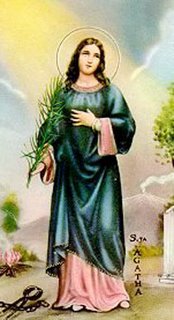Ante Diem VIII Idus Februarias

Modern Date : February 6th
Ante Diem VIII Idus Februarias
Eighth Day to the Ides of February
This is one of the dies nefasti a day on which no legal action or public voting could take place. The dies nefasti of February were days of religious ceremony honoring the dead and heralding the rebirth of the Spring and its associated fertility.
On this day in 52 BCE, Pompey spoke before the people and Roman senate in defense of Milo, after Clodius was killed, but was harassed with shouts of abuse.
On this day in 46 BCE Julius Caesar was victorious at the battle of Thapsus in North Africa.
February is a month sacred to the gods Mars (as Quirinus, or Romulus) and Juno, the wife of Jupiter. Juno (Hera) was the mother of Mars, called Ares by the Greeks, and sometimes Enyalius. Ares was often accompanied in his bloody campaigns by Enyo, the murderess goddess of war who was known as Bellona by the Romans. Ares paid no attention to which cause was right or wrong and was concerned only with where he could cause maximum carnage.
Festival of Aphrodite
In Greece, this day was the Festival of Aphrodite, who the Romans knew as Venus. Aphrodite, the goddess of love and beauty, was the daughter of Zeus and Dione. She was known to the Phoenicians as Astarte and Ashtoreth to the Hebrews and King Solomon, who built a temple to her. On her birth the seas bubbled and turned rosy, and she arose, full grown and standing on a seashell, in all the surpassing glory of her loveliness and arrayed in the panoply of her irresistible charms. She floated to Cyprus, arriving in April, and as soon as her white feet touched the shore, grass and flowers sprang up at her feet and she was sweetly received by the Three Graces.
Sapporo Snow Festival
The Sapporo snow festival in northern Japan is held to honor the spirits who bring water to the island. Miniature shrines are created in igloo-like structures, and for one night, children are allowed to wait in these huts, receiving visits from family and friends. The festival began in 1950 when local high school students made six snow statues in Odori Park along the city's main street. It attracted an unexpected number of spectators and, through the following years, the festival gradually became a part of life in Sapporo. Today the festival has grown to Hokkaido's biggest winter event and attracts more than 2 million visitors annually.
St Dorothy
This virgin martyr of the third century is the patron of gardeners and is usually shown with a laden basket because she was on her way to her place of execution, when a lawyer, Theophilus, jokingly suggested she send him a basket of heavenly fruits and flowers whereupon a child appeared with a basket of apples and roses. This convinced Theophilus who converted and also suffered martyrdom.
Homage to the Stars
The lantern festival ceremonies which usually occur around the full moon of the first lunar month in China, can begin as early as the eighth day. One hundred and eight lamps are lit at dusk and placed in prominent places around the dwelling including on the well, the kitchen stove, the washing stone, and near gates and doors in a ceremony called "scattering the lamps." Li-Ch'en observes: "Grouped together they look like fireflies; scattered, like stars."

